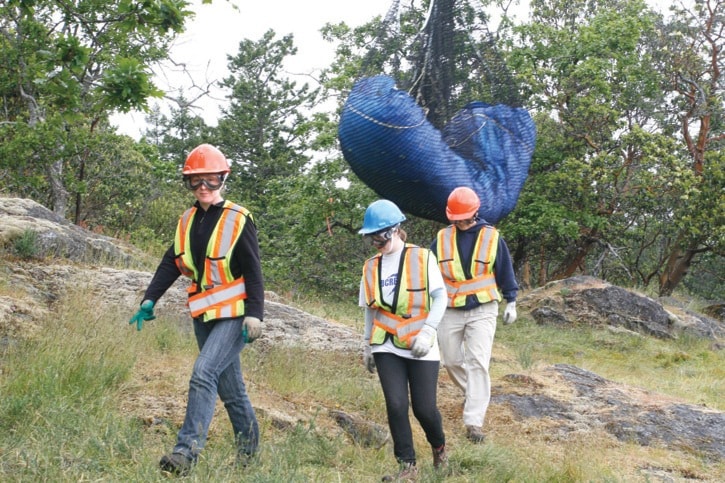Even with more than a metric tonne of Scotch broom removed, the bright, vibrant, yellow flowers of the invasive plant still light up Mill Hill.
A helicopter air lifted four large bundles of broom off the hill and lowered them to the Mill Hill regional park parking lot last Thursday.
This year the broom crew focused on the east meadow on the back of Mill Hill and concentrated on about two hectares of land. Alpine Recycling shreds the broom and mixes it with wood chips for use as a biofuel at facilities such as Dockside Green.
“It’s a good use for the resource,” said Marilyn Fuchs, Capital Regional District environmental specialist.
This is the 10th year for the Mill Hill Restoration Project. While one tonne is a huge accomplishment for the crew, it is less broom removed than in most years.
Each day for two weeks, six to eight CRD staff members would hike the hill and cut broom. In previous years the crew numbered about 12 people plus a crew leader, said Jamie Hamel, a park maintenance worker.
“We didn’t get the funding this year so our resources were limited,” Hamel said.
“The funding was frozen when the (federal) election was called,” Fuchs noted.
Along with cuts to the eradication crews, CRD was unable to fund its scientific monitoring component to the Mill Hill Restoration Project, ongoing for about seven years.
Botanists hired by the CRD monitor specific plants on the hill and count all the rare native plant species.
“It takes weeks of intense work,” Fuchs said. “They have sticks that they put down in the ground when the see a given plant. Then they go back and pick up all the sticks and count them.”
The native plant species White-top aster is used as an indicator of successful broom eradication.
“We saw a pronounced increase in numbers (of aster) where the broom has been removed,” Fuchs said.
The botanists also monitor experimental stations on the hill. Crews mark out paired five by five metre plots, where one plot broom is removed and in the other it is left to flourish.
“When we first remove the broom we get a flush of broom seedlings and other invasive grasses. But two to three years after the broom has been removed some of the native species move back in,” Fuchs said. “We wouldn’t know that without the monitoring. It was good to see that.”
While the CRD still may receive funding this year for the scientific program, due to plant seasons it would be too late to do the native flower count.
The CRD also has another avenue to give the native species on the hill and break. It is encouraging people to stay on marked trails to avoid damaging native plants and spreading around dormant broom seeds.
“Trampling of rare plants and other native species cause soil disturbances,” Fuchs said.
Crews cut broom twice per year on Mill Hill, once with CRD staff, and then in the fall with volunteers who want to help with the broom infestation.
“(In the spring) the yellow shrubs are easy to spot,” Fuchs said. “Even though it is a sensitive time of year, it is important to stay ahead of that seed bank.”
reporter@goldstreamgazette.com
